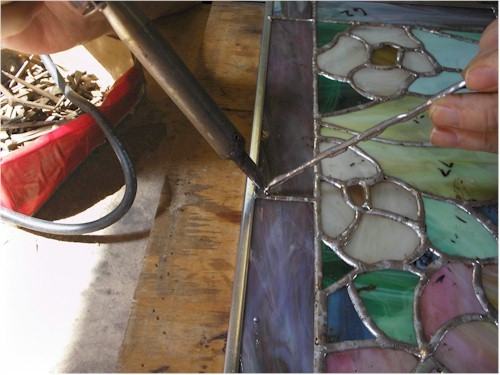Reclaiming Old Flux Core Solder For Use In Stained Glass
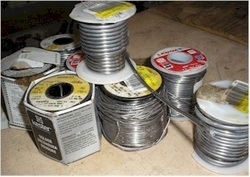
The solder here was cheap but it's filled with both acid core and rosin core flux inside the solder itself. If it is soldered directly to a window, the window will get these fluxes deposited to it and it will be difficult, if not impossible, to get clean.
The acid will act to try to dissolve and weaken the window and the rosin core will smudge and leak and the window will be hazy.
The acid will act to try to dissolve and weaken the window and the rosin core will smudge and leak and the window will be hazy.
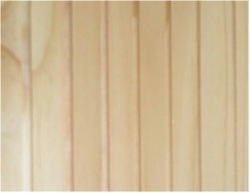
Start by sawing 1/8" wide and 1/8" deep grooves in a board.
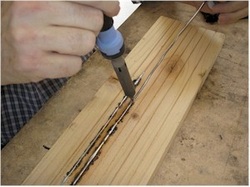
Then melt solder with an iron into the grooves.
A fan should blow over the work area to carry fumes away. We left doors to the studio open so the smoke would be dissipated.
A fan should blow over the work area to carry fumes away. We left doors to the studio open so the smoke would be dissipated.
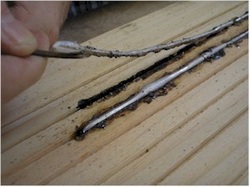
You will find that when the solder has cooled, you can pry the stick of solder away from the board.
I used a horseshoe nail to do the job.
I used a horseshoe nail to do the job.

A quick rub with a rag cleans off the acid core solder pieces pretty well
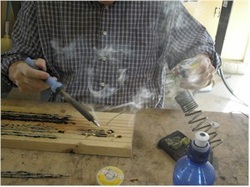
The Rosin-core solder really smokes.
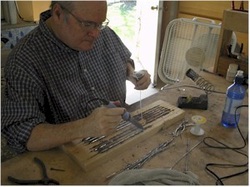
The box fan in the back ground clears the air.
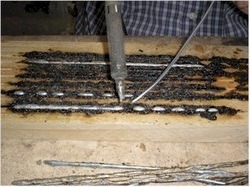
You may find that if you drip segments of solder and come back to fill them in, the process will be easier.
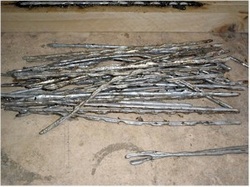
Once you have a bunch of solder sticks..
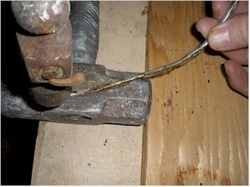
..you'll want to tap them with a hammer, all along each side. This will break the rosin left on the solder off pretty well.
I used a hammer as an anvil and a smaller one to tap off the rosin.
I used a hammer as an anvil and a smaller one to tap off the rosin.
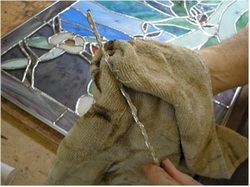
Then rub it with a cloth and ..
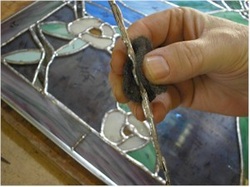
..scrub the stick with steel wool.
You'll then be able to use the solder without making your glass a mess.
It's a lot of work to prepare solder for use, but the difference between $3 a pound and $22 a pound may make it worth your while (or you may agree with me that the extra expense is worth the labor savings!)
.....................................................
A Stained Glass Artist sent me his techniques in an e-mail after this article was published:
"I used to teach soldering to government specifications. We used a rosin flux (not integrated with the solder) and used alcohol to clean the pieces we were working on. Let the 'new' solder rods you create set in an alcohol bath. I would do this outdoors because of the alcohol fumes. Most all of the rosin will dissolve in the alcohol. That which doesn't can be wiped off with an old rag or paper towels.
I am also a fisherman who makes his own lead weights. I bought a steel pan at a flea market and used that. I heat the solder in the pan.
I use an old single burner hot plate for this. Everything is clearly marked 'FOR LEAD ONLY', 'NO FOOD'. I have an old board that has four smaller pieces glued and nailed to it to create a trough. When the lead is melted, I simply pour the molten lead into the trough. As soon as it sets, I remove the lead from the trough and spray with cold water. The shock of the water on the lead will help in getting the flux to fall off. The Tray I use is 1/4" wide, 1/2" deep, and 12" long."
I hope this might help - - - Joseph
.....................................................
A Stained Glass Artist sent me his techniques in an e-mail after this article was published:
"I used to teach soldering to government specifications. We used a rosin flux (not integrated with the solder) and used alcohol to clean the pieces we were working on. Let the 'new' solder rods you create set in an alcohol bath. I would do this outdoors because of the alcohol fumes. Most all of the rosin will dissolve in the alcohol. That which doesn't can be wiped off with an old rag or paper towels.
I am also a fisherman who makes his own lead weights. I bought a steel pan at a flea market and used that. I heat the solder in the pan.
I use an old single burner hot plate for this. Everything is clearly marked 'FOR LEAD ONLY', 'NO FOOD'. I have an old board that has four smaller pieces glued and nailed to it to create a trough. When the lead is melted, I simply pour the molten lead into the trough. As soon as it sets, I remove the lead from the trough and spray with cold water. The shock of the water on the lead will help in getting the flux to fall off. The Tray I use is 1/4" wide, 1/2" deep, and 12" long."
I hope this might help - - - Joseph



